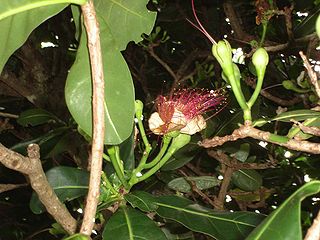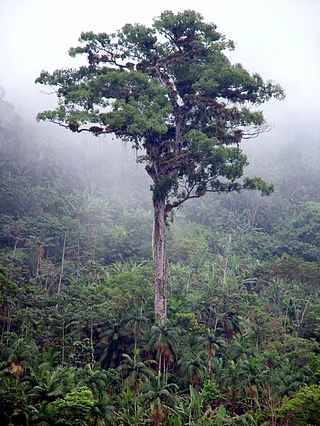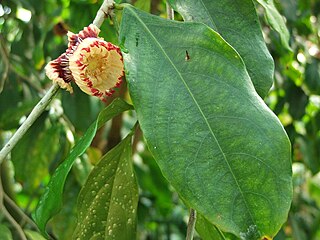
The Lecythidaceae comprise a family of about 20 genera and 250–300 species of woody plants native to tropical South America, Africa, Asia and Australia.

Couroupita guianensis, known by a variety of common names including cannonball tree, is a deciduous tree in the flowering plant family Lecythidaceae. It is native to lowland tropical rainforests of Central and South America, from Costa Rica, south to Brazil and northern Bolivia and it is cultivated in many other tropical areas throughout the world because of its fragrant flowers and large fruits, which are brownish grey. There are potential medicinal uses for many parts of Couroupita guianensis, and the tree has cultural and religious significance in South and Southeast Asia. In Sri Lanka and India, the cannonball tree has been widely misidentified as the Sal tree, after its introduction to the island by the British in 1881, and has been included as a common item in Buddhist temples as a result.

Cauliflory is a botanical term referring to plants that flower and fruit from their main stems or woody trunks, rather than from new growth and shoots. It is rare in temperate regions but common in tropical forests.

Grias is a genus of flowering plants in the family Lecythidaceae, described by Linnaeus in 1759. It is native to northwestern South America, Central America, and Jamaica.

Couratari is a genus of trees in the family Lecythidaceae, first described as a genus in 1775. They are native to tropical South America and Central America.

Asteranthos is a genus of woody plant in the family Lecythidaceae. There is only one known species, Asteranthos brasiliensis, native to Venezuela and Brazil.

Cariniana is a genus of trees in the family Lecythidaceae, first described as a genus in 1842. The entire genus is native to South America. Many are of importance for timber production. Species of this genus may be known commonly as jequitibá.
Corythophora is a genus of woody plant in the Lecythidaceae family first described as a genus in 1939. It is native to northeastern South America.
- Corythophora altaR.Knuth - Pará, Amazonas
- Corythophora amapaensisPires ex S.A.Mori & Prance - French Guiana, Amapá
- Corythophora labriculata(Eyma) S.A.Mori & Prance - Suriname
- Corythophora rimosaW.A.Rodrigues - French Guiana, Amazonas, Amapá, Suriname

Lecythis is a genus of woody plant in the Lecythidaceae family first described as a genus in 1758. It is native to Central America and South America. Several species produce edible seeds and referred to by a variety of common names including paradise nut, monkey pot, cream nut, and sapucaia nut.

Napoleonaea is a genus of woody plant in the family Lecythidaceae first described as a genus in 1804, the same year its namesake crowned himself Emperor of the French. The genus is native to Africa.
Couroupita nicaraguarensis, the bala de cañón, coco de mono, paraíso, zapote de mico, or zapote de mono, is a species of woody plant in the family Lecythidaceae. It is found in Colombia, Costa Rica, Ecuador, El Salvador, Nicaragua, Puerto Rico and Panama. It is threatened by habitat loss. In Puerto Rico, the only place it is found at is Toa Alta, Puerto Rico.

Gustavia is a genus of flowering plants in the family Lecythidaceae described by Linnaeus in 1775. It is native to tropical Central America and South America. Many of the species are threatened; some are critically endangered Gustavia superba, though, is actually abundant in re-growing secondary forests. It grows in northern South America, from Panama south through the Andes as far as Ecuador, and along the Caribbean coast and in the Amazon basin. Gustavia flowers have numerous stamens, in some species as many as 1,200 in a single flower.

Lecythis zabucajo, the sapucaia or paradise nut, is a large nut-producing tree occurring in the Guianas, Suriname, Venezuela, Ecuador, Honduras and Brazil, and which distribution range is much the same as that of the greater spear-nosed bat. Although not singling out Lecythis zabucajo, Jacques Huber noted in 1909 that fruit bats played the most important role in seed dispersal in Amazonian forests. The quality of its nuts led to the species' being introduced to numerous tropical countries, notably Trinidad, where it has flourished. The nuts are a valuable food resource and yield oil suitable for cooking and domestic use.

Lecythis ampla is a species of woody plant in the family Lecythidaceae, which also includes the Brazil nut. Common names include coco, olla de mono, jicaro and salero. It is found in Central and South America. It has been considered an endangered species in Costa Rica.

Pouteria viridis is a species of flowering plant in the family Sapotaceae known by the common name green sapote.
Allantoma is a genus of woody plant in the family Lecythidaceae first described as a genus in 1874. It is native to northwestern South America (Colombia, Venezuela, Peru, northern Brazil.
- Allantoma decandra S.A.Mori, Ya Y.Huang & Prance - Peru, Brazil
- Allantoma integrifolia S.A.Mori - Amazonas State in Brazil
- Allantoma kuhlmannii S.A.Mori - Rondônia State in Brazil
- Allantoma lineata Miers - Amazonas State in Venezuela; Amazonas and Pará States in Brazil
- Allantoma pachyantha S.A.Mori, Ya Y.Huang & Prance - Amazonas State in Brazil
- Allantoma pauciramosa S.A.Mori, Ya Y.Huang & Prance - Amazonas State in Brazil
- Allantoma plurifloraS.A.Mori, Ya Y.Huang & Prance - Colombia
- Allantoma uaupensis S.A.Mori, Ya Y.Huang & Prance - Amazonas State in Brazil
Petersianthus is a genus of woody plant in the Lecythidaceae family first described as a genus in 1865 under the name Petersia. This turned out to be an illegitimate homonym, meaning that it had already been used by someone else to refer to a very different plant. So the name of these species in the Lecythidaceae was changed to Petersianthus. It is native to the Philippines and to parts of Africa. The following two species belong to this genus, with the basionyms of both taxa belonging to what is known today as the family Combretaceae.
- Petersianthus macrocarpus(P.Beauv.) Liben - Guinea, Ivory Coast, Cameroon, Congo Republic, Democratic Republic of the Congo, Cabinda, Gabon, Angola
- Petersianthus quadrialatus(Merr.) Merr. - Philippines

The Catatumbo moist forests (NT0108) is an ecoregion in Venezuela and Colombia to the west and east of Lake Maracaibo. It includes four regions of moist forest on slightly higher ground than the dry forest and mangroves that surround the lake. The forest has unique flora related to the flora of the Amazon basin. It is badly degraded due to farming, livestock grazing and oil exploration.

Scott Alan Mori was a Swiss and American botanist and plant collector. He specialized in the systematics and ecology of neotropical Lecythidaceae and Amazonian and Guianian floristics.

Moquilea platypus, also known as sun sapote, sansapote, and monkey apple, is a flowering tree in the family Chrysobalanaceae. The specific epithet (platypus) is Neo-Latin for "flat-footed".















